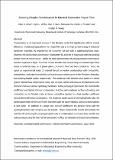| dc.contributor.author | Antao, Dion S | |
| dc.contributor.author | Wilke, Kyle L | |
| dc.contributor.author | Sack, Jean H | |
| dc.contributor.author | Xu, Zhenyuan | |
| dc.contributor.author | Preston, Daniel J | |
| dc.contributor.author | Wang, Evelyn N | |
| dc.date.accessioned | 2022-04-25T15:42:07Z | |
| dc.date.available | 2022-04-25T15:42:07Z | |
| dc.date.issued | 2020 | |
| dc.identifier.uri | https://hdl.handle.net/1721.1/142053 | |
| dc.description.abstract | © 2020 Condensation is an important process in the Rankine cycle that significantly affects overall efficiency. Condensate typically forms a liquid film due to the high surface energy of industrial condenser materials; by engineering the condenser surface with a superhydrophobic layer, however, we can increase condensation heat transfer by an order of magnitude with the jumping droplet mode of condensation. While the basic phenomenon of jumping droplet condensation has been explored in depth, its effects on heat transfer and pressure drop in confined vapor flow inside a condenser tube, as in power plant condensers, have not been considered. Here, we report an experimental study of internal forced convective condensation with hydrophilic, hydrophobic, and superhydrophobic surfaces to study condensation in the filmwise, dropwise, and jumping droplet modes, respectively. The condenser tube samples were tested in a closed system internal flow condensation setup, and the heat transfer and pressure drop behavior were characterized over various operating conditions. In the jumping droplet mode, the heat transfer coefficient was highest at lower condensation heat flux and condenser surface subcooling, but a transition to the flooded mode at higher subcooling resulted in a heat transfer coefficient comparable to filmwise condensation. For dropwise condensation in the hydrophobic tube, the condensation heat transfer coefficient increased with the vapor velocity, similar to observations in past work. In addition to a large heat transfer coefficient, the pressure drop with the superhydrophobic tube samples was the lowest. These experimental results demonstrate the viability of harnessing the jumping droplet mode of condensation to enhance heat transfer and reduce pressure drop for internal forced convective flow condensation in industrial condensers. | en_US |
| dc.language.iso | en | |
| dc.publisher | Elsevier BV | en_US |
| dc.relation.isversionof | 10.1016/J.IJHEATMASSTRANSFER.2020.120398 | en_US |
| dc.rights | Creative Commons Attribution-NonCommercial-NoDerivs License | en_US |
| dc.rights.uri | http://creativecommons.org/licenses/by-nc-nd/4.0/ | en_US |
| dc.source | Prof. Evelyn Wang | en_US |
| dc.title | Jumping droplet condensation in internal convective vapor flow | en_US |
| dc.type | Article | en_US |
| dc.identifier.citation | Antao, Dion S, Wilke, Kyle L, Sack, Jean H, Xu, Zhenyuan, Preston, Daniel J et al. 2020. "Jumping droplet condensation in internal convective vapor flow." International Journal of Heat and Mass Transfer, 163. | |
| dc.contributor.department | Massachusetts Institute of Technology. Department of Mechanical Engineering | |
| dc.relation.journal | International Journal of Heat and Mass Transfer | en_US |
| dc.eprint.version | Author's final manuscript | en_US |
| dc.type.uri | http://purl.org/eprint/type/JournalArticle | en_US |
| eprint.status | http://purl.org/eprint/status/PeerReviewed | en_US |
| dc.date.updated | 2022-04-25T15:34:33Z | |
| dspace.orderedauthors | Antao, DS; Wilke, KL; Sack, JH; Xu, Z; Preston, DJ; Wang, EN | en_US |
| dspace.date.submission | 2022-04-25T15:34:35Z | |
| mit.journal.volume | 163 | en_US |
| mit.license | PUBLISHER_CC | |
| mit.metadata.status | Authority Work and Publication Information Needed | en_US |
